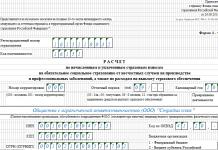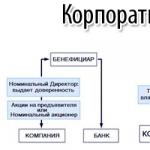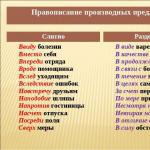The new form 4-FSS is a calculation of insurance premiums in case of injury. The calculation also reflects data on accident benefits, medical examinations of employees and workplaces.
The calculation form was approved by order of the Federal Social Insurance Fund of Russia dated 06/07/2017 No. 275. The electronic calculation format and control ratios were approved by the orders of the Federal Social Insurance Fund dated 03/09/2017 No. 83 and dated 09/11/2017 No. 416.
Who is renting? The 4-FSS report is submitted by all payers of contributions for injuries. These include organizations and individual entrepreneurs who pay payments to individuals under employment contracts or civil liability agreements, in which the employer has provided for the payment of insurance premiums. Entrepreneurs without employees are not registered with the Social Insurance Fund. An exception is that the individual entrepreneur decided to voluntarily pay insurance premiums.
Where to submit. Organizations submit the new 4-FSS to the FSS department at their location. Entrepreneurs submit a 4-FSS report to the FSS branch at their place of residence. If a company division itself issues payments to individuals, the new Form 4-FSS must be submitted at the place of registration of the division.
What is the due date? The deadlines for submitting Form 4-FSS vary depending on the form in which it is submitted. The electronic 4-FSS report must be submitted by the 25th of the month after the reporting period, and the paper report by the 20th. It turns out that you must report for 2018 in 2019. The deadlines are as follows: no later than January 21, 2019 on paper and no later than January 25, 2019 in electronic form.
Companies and individual entrepreneurs whose average number of employees is more than 25 people are required to submit Form 4-FSS electronically. Other organizations and entrepreneurs can submit either on paper or electronically.
Articles on the topic “Form 4-FSS”:
The deadline for submitting a paper report in Form 4-FSS for the 2nd quarter of 2019 has been postponed. The report must be submitted electronically according to the general rules. We have given all the new deadlines for the 1st, 2nd, 3rd and 4th quarters, taking into account the changes, in the table in the article. 43326
Form 4-FSS - a sample of filling out for the 1st quarter of 2019 with zero data you can see in our material. Here you will find a description of the mechanism for filling out such a report, find out which sheets do or do not need to be completed, and receive other important information on drawing up a zero 4-FSS.
What does the legislation say about zero 4-FSS?
Reporting to social security in Form 4-FSS is a calculation presented in tabular form, containing information:
- on insurance premiums for compulsory insurance against accidents at work and occupational diseases (ASP and OPD), accrued and paid in the reporting period (for injuries);
- expenses for payment of insurance coverage under NSP and PZ.
Zero calculation 4-FSS is a type of insurance reporting in the absence of reporting data. This situation arises if the company has suspended, ceased or is just planning to start operations.
The condition for the mandatory submission of such a calculation is contained in Art. 24 of the Law “On compulsory social insurance against accidents at work and occupational diseases” dated July 24, 1998 No. 125-FZ. This article speaks of the need for quarterly reporting on insurance premiums by all policyholders.
Find out who is taking the 4-FSS from this article.
Please note: an individual entrepreneur without employees does not submit a zero card to the Social Insurance Fund, since he is not an insurer.
There is no mention of zero form 4-FSS in the law. Nothing is said about this type of reporting in the FSS order No. 381 dated September 26, 2016, which describes the technology for filling out this reporting form.
However, this does not mean that the lack of reporting data relieves policyholders from submitting 4-FSS - everyone needs to report every reporting quarter. We will tell you how to do this in the following sections.
Mandatory zero sheets
Social insurance expects 4-FSS from policyholders in any case - whether they made payments in the reporting period in favor of individuals or not. If there is nothing to write down in the report, the employer will be required to submit a 4-FSS zero calculation completed according to special rules.
Its main difference from a regular (data-filled) calculation is the reduced volume of tables presented.
Calculation 4-FSS - 2019 is filled out on the form approved by. by order of the FSS dated September 26, 2016 No. 381, as amended. from 06/07/2017. You can download it below.
The minimum set of sheets and tables of the report is defined in clause 2 of Appendix No. 2 to Order No. 381 - it includes:
- title page;
- 3 tables (1 - calculation of the base for calculating insurance premiums, 2 - calculation of injury premiums and 5 - results of assessing working conditions).
These are mandatory sheets for 4-FSS. The remaining calculation tables (1.1, 3 and 4) may not be filled out - this is indicated in clause 2 of the Procedure for registration of 4-FSS, approved. by order No. 381 (Appendix No. 2). Therefore, you can create a zero calculation without them.
We will talk about the specifics of filling out the cells of the zero calculation tables in the next section.
How to prepare a report if there is no data - zeros, dashes or empty cells?
To correctly fill out the zero calculation in Form 4-FSS, use the algorithm set out in Appendix No. 2 to Order No. 381:
|
Clause of Appendix No. 2 to Order No. 381 |
Decoding |
|
Dashes are added to table cells if there is no reporting indicator. |
|
|
When filling out the “TIN” field in the 2 initial cells (zone of 12 cells), enter zeros (00) if the TIN consists of 10 characters. How to find out the FSS registration number by TIN in a couple of minutes, see the material |
|
|
In the 1st and 2nd cells of the field “OGRN (OGRNIP) of the legal entity, enter zeros (their OGRN consists of 13 characters with a 15-digit zone to be filled in) |
In addition, individual calculation cells are not filled in at all - neither with zeros nor dashes. For example:
- the field “Cessation of activity” located on the title page - according to clause 5.6 of Appendix No. 2 to Order No. 381, code “L” is entered in this field (if the company or individual entrepreneur is liquidated in the reporting period) or it is not filled in at all;
- field “Budgetary organization” - only state employees work with it (clause 5.12 of Appendix No. 2 to Order No. 381), and in the reporting of other companies and individual entrepreneurs it remains blank.
From these features of the calculation filling technique, the following conclusion can be drawn:
- zeros are entered only in the 1st and 2nd cells of the “TIN” and “OGRN” fields if the value indicated in them consists of 10 or 13 characters, respectively;
- In the cells of the form tables, if there is no data, dashes are inserted;
- individual cells for a specific purpose are left unfilled.
If you generate several different reports in parallel at once, read the next section to protect yourself from errors.
Technology of filling out calculations - how not to make a mistake?
The above method of filling out the fields is typical only for 4-FSS. When preparing, for example, the calculation of contributions, a different scheme is used (clause 2.20 of Appendix No. 2 to the Federal Tax Service order No. ММВ-7-11/551@ dated 10.10.2016):
- 12 acquaintances of the “TIN” field of a single calculation for insurance premiums must be filled out from the first cells, and with a 10-digit TIN, dashes are entered in the last 2 cells (for example, 8970652349--);
- missing indicators (quantitative and total) are filled with zeros; in other cases, empty cells are crossed out.
For a sample of a zero single calculation for insurance premiums, please see the link.
Do not confuse these technical features of the design of different reporting forms, otherwise problems may arise with the timely acceptance of the 4-FSS calculation by social insurance specialists. They may not accept the calculation on formal grounds - due to non-compliance with the procedure established by law for filling it out.
Find out how much the policyholder will have to pay if, due to a technical or other error, the calculation is not submitted on time.
When are numerical values entered in the zero report tables in the absence of “insurance” charges and payments?
The described scheme for filling out the calculation (namely, putting dashes in those table cells for which there are no indicators) cannot be used using the continuous method. That is, when filling out the zero calculation of 4-FSS, it is also necessary to take into account the peculiarities of filling out individual cells. Including:
|
Calculation cell 4-FSS |
Explanation for filling |
|
|
Row 5 of table 1 |
The line cannot be crossed out (there is information to fill it out) - write down the insurance rate in it, which is set for each policyholder depending on the class of professional risk. How the tariffs indicated in 4-FSS are set and what they depend on, find out |
|
|
Rows 6 and 7 of table 1 |
Cross out the lines only if the tariff does not include a discount or surcharge |
|
|
Line 8 of table 1 |
If you have received a tariff premium, in line 8 indicate the date of the corresponding FSS order |
|
|
Line 9 of table 1 |
Always fill out the line - it will reflect:
|
|
|
Row 1 of table 2 |
In the line, enter the amount of debt to social insurance for contributions from NSP and PZ at the beginning of the billing period (if there is such a debt) - it is reflected in the accounting (for loan account 69) and confirmed by the results of reconciliation with the fund. Compare it with the amount reflected on page 19 of the 4-FSS calculation for the previous year - the indicators should match |
|
|
Row 3 of table 2 |
Fill out this line if the Social Insurance Fund has accrued injury contributions based on the results of desk or on-site inspections |
|
|
Row 4 of table 2 |
Expenses not accepted for offset by the Social Insurance Fund for previous billing periods based on inspection reports are reflected here. |
|
|
Row 5 of table 2 |
On this line, reflect the amount of contributions accrued by you for previous billing periods that are subject to payment (if any such accruals exist) |
|
|
Row 6 of table 2 |
Fill out this line if your account has received reimbursement from social insurance that exceeds the amount of accrued injury contributions. |
|
|
Row 7 of table 2 |
The line is filled in by companies and individual entrepreneurs if they have received a refund of overpaid contributions from social insurance. |
|
|
Row 8 of table 2 |
The line contains a numeric value, if pages 1-7 (or some of them) reflected non-zero values - the indicators on pages 1-7 are summed |
|
|
Lines 9,14.1 of table 2 |
These lines reflect the debts of the Social Insurance Fund to the policyholder (at the end and beginning of the billing period) |
Find out the technology for preparing the latest 4-FSS table in the next section.
Where can I get the information for Table 5?
Always fill out this table, regardless of whether the indicators are in the other calculation tables or not. It is devoted to the results of a special assessment of working conditions (SOUT) and mandatory medical examinations performed at the beginning of the year.
Please put dashes in all cells if you have registered as an insured this year. Other companies and individual entrepreneurs need to collect information:
- from the personnel service - about the number of jobs (this information is needed for column 3), the number of employees required to undergo medical examinations (column 7) and those who have already passed them (column 8);
- from the SAW report - on the number of certified workplaces, including those classified as harmful and dangerous working conditions (columns 4-6).
We'll tell you what the law on SOUTH refers to as harmful working conditions.
Sample 4-FSS with an example for a novice policyholder
Let's consider the scheme for filling out 4-FSS 2019 for a company created in the 3rd quarter.
Example
Initial data:
- Stroika Plus LLC was registered in August 2019.
- At the end of the 3rd quarter, activities had not yet begun, staff had not been recruited, payments had not been made, insurance premiums had not been paid.
- Only the director is on staff.
- The injury contribution rate is 2.3% (without discounts or surcharges).
- The SOUT is scheduled for December 2019.
Despite the lack of activity, in October 2019 the company will be required to submit its first calculation to social insurance in Form 4-FSS. It will be null because there is no data to fill:
- table 1—no injury charges were accrued;
- table 2 - Stroika Plus LLC did not conduct mutual settlements with the Social Insurance Fund;
- table 5—there is no information about the results of special assessment tests and mandatory medical examinations.
How to complete a zero calculation, see the sample of filling out 4-FSS, latest edition 2019.

Results
All policyholders fill out the 4-FSS calculation form. If they did not work during the reporting period or temporarily suspended their work, they must submit a zero calculation on this form. If there is no reporting data, you need to fill out 3 mandatory tables (1, 2 and 5).
1. The title is drawn up by the payer of contributions, except for the block intended to be filled out by a fund employee.
2. The correction number line should be “000” when submitting the form for the first time. If there is a need to correct previously submitted information, updated reports are submitted indicating codes “001”, “002”, etc.
Important: the updated report should be submitted on the form that was valid in the billing period for which inconsistencies were identified.
3. In the “Reporting period” field, enter the period code and the number of requests from the employer for reimbursement of social security funds.
This field is filled in as follows:
- when submitting a report for the 1st quarter, half year, 9 months. and year, only the first two cells are filled in, indicating the codes: “03”, “06”, “09” and “12” respectively;
- when the policyholder applies for the allocation of funds before the end of the reporting (settlement) period (when submitting an interim calculation), only the last two cells are filled in, the serial number of the application is indicated: “01”, “02”, etc.;
- when applying for compensation based on the results of the reporting (settlement) period, indicate the period code and the serial number of the application.
4. The “Calendar year” field indicates the year for which (during which) the information is being submitted.
5. The “Cessation of activity” cell is filled in only when the policyholder is liquidated; in this case, the letter “L” is entered.
When filling out the TIN and OGRN codes for legal entities, zeros are placed in the first two cells.
7. The OKVED code is filled in. At the same time, newly created entities indicate the code according to the registration documents, and starting from the second calendar year of activity, they enter the code confirmed by the Social Insurance Fund.
8. The corresponding indicator in the “Budgetary organization” cell is entered only by state employees indicating the code of the source of funding.
10. The following lines indicate the average number of the insurer's personnel, as well as the number of disabled workers and workers in hazardous industries.
11. The number of pages of calculation and supporting documents is indicated next to it.
12. Then fill in the “Confirmation of information accuracy” block.
The code of the person who signed the calculation is indicated:
- “1” – if the form is signed by the head of the organization (individual entrepreneur, individual who is not an individual entrepreneur);
- “2” – if the calculation is certified by a representative of the policyholder;
- “3” – if the information is confirmed by the legal successor of the liquidated company.
Then indicate your full name. such person (name of the successor company), his signature and date. A seal impression (if any) is affixed below.
If the calculation is signed by a representative, fill in the name and details of the document confirming his authority.
The report on form FSS-4 is submitted to the Social Insurance Fund (Sotsstrakh) by all employing organizations. This type of reporting reflects the amount of insurance premiums paid by the organization to the Social Insurance Fund for its employees, drawn up under any of the existing types of contracts.
Traditionally, the FSS-4 form includes insurance premiums themselves (at a fixed rate), information about the employer’s expenses for paying for temporary sick leave (sick leave), as well as maternity-related maternity leave and the like.
A separate section contains contributions “for injuries”, that is, calculations of the amounts of contributions paid to insure employees against accidents in the workplace. In addition, the same form includes information about the certification of employees’ workplaces for compliance with established requirements and the necessary medical examinations.
Changes for 2018
 The main news in the field of calculating insurance premiums in 2017 was that the Social Insurance Fund and the Federal Tax Service divided between themselves the calculations and verification of insurance amounts paid.
The main news in the field of calculating insurance premiums in 2017 was that the Social Insurance Fund and the Federal Tax Service divided between themselves the calculations and verification of insurance amounts paid.
Accordingly, the section concerning the calculation of insurance premiums for temporary disability and disability associated with maternity has been completely “relegated” to the tax service, and has been excluded from Form No. 4 for the Social Insurance Fund. This is certified by Order of the Federal Social Insurance Fund of the Russian Federation No. 381 dated September 26, 2016 and Federal Law No. 243-FZ dated July 3, 2016.
The new name of this type of reporting: “Calculation of accrued and paid insurance contributions for compulsory social insurance against accidents at work and occupational diseases, as well as expenses for the payment of insurance coverage (form 4-FSS).”
Thus, in the FSS-4 form there are only sections related to:
- general calculation of the insurance premium base;
- calculation of injuries at work, occupational diseases, and so on;
- providing general information about the assessment of working conditions and the state of workplaces.
In addition, the changes practically did not affect the additional tables of the form, which are filled out only as data is available, such as calculations of conditions that give the right to a reduced tariff, an indication of the number of victims in the workplace (if any occurred), and so on.
No changes are planned for 2018.
Important nuances
Despite the fact that reporting on maternity leave, maternity leave and sick leave is no longer submitted to the Social Insurance Fund, the necessary payments are still made by the Social Insurance Fund, and not by the tax service.
Among the others important nuances can be designated:
- each page of the report is certified by the signature of the person authorized to submit the report;
- it became possible to correct clerical errors in a report on paper, that is, incorrect data - the error should be crossed out (the use of correctors is prohibited), the true value should be entered next to it, the corrected value should be certified with a signature and date;
- the report itself now consists of only five tables, of which the first, second and fifth are mandatory;
- the third and fourth tables are filled in only as needed.
In addition, the report now indicates not the full amount, but the insured employees at the end of the reporting period.
Sample filling
 Before moving on to the rules for filling out the FSS-4 form, we note that according to the latest rules, all organizations with 25 or more employees are required to submit this report only in electronic form, using a special program. To do this, you need to have enhanced qualifications.
Before moving on to the rules for filling out the FSS-4 form, we note that according to the latest rules, all organizations with 25 or more employees are required to submit this report only in electronic form, using a special program. To do this, you need to have enhanced qualifications.
Submitting a report on paper is acceptable only for small companies. In this case, the form is filled out with a ballpoint or fountain pen, exclusively with blue or black (not purple!) ink, and block letters. As mentioned above, corrections are acceptable if they are carefully, with the ability to read the crossed out data, corrected by the person who made them, and certified by his signature and date.
The paper version is endorsed by the signature of the head of the organization or an authorized representative on each (!) sheet. The electronic one is protected by an enhanced qualified electronic signature, which must first be obtained from an authorized organization.
The new FSS-4 form consists of:
- title page;
- Table 1 - calculation of the base for calculating insurance premiums;
- Table 2 - calculation of the base for social insurance against accidents at work and occupational diseases;
- Table 3 - actual expenses incurred for insurance against accidents and occupational diseases;
- Table 4 - the number of insured victims of workplace injuries for the reporting period;
- Table 5 - information on the results of workplace certification for working conditions and mandatory medical examinations of workers at the beginning of the year.
Filling out the form begins with the title page, on which the following is indicated in the relevant sections:
- Registration number of the policyholder, that is, the employer company.
- Subordination code - the number of the local branch of the Fund where the enterprise is registered.
- In the “Adjustment number” field, a three-digit code indicates whether this is a primary report for a given period (code 000), or whether it is a report with changes made (codes from 001 to 010 inclusive).
- In the column “Reporting period (code)” the codes of the reporting periods (quarters) and the total number of cases when the policyholder applied to the Fund for funds to pay insurance are entered. The code is indicated in the first two cells and is marked as “03”, “06”, “09” or “12”, which, respectively, is the first, second, third quarters and the billing period of the year (last, fourth quarter). If this report is submitted only to receive funds from the fund to pay insurance coverage, then only latest two cells of this column. The number of hits is marked as “01..10”.
- In the “Calendar year” column, the year that was the billing period when drawing up the report is indicated accordingly (the billing period includes three reporting quarters).
- The column “Cessation of activity” is filled in as necessary.
- The next field indicates the full name of the insured organization in accordance with, in the case of filing a report by an individual entrepreneur or other individual - full name.
- Next, you need to indicate the TIN, KPP, OGRN and in the appropriate fields. After this, the landline or mobile phone number of the policyholder without dashes and brackets, only numbers, and the legal address is indicated on the title page.
- At the final stage, the number of disabled employees and employees engaged in hazardous/hazardous work is indicated on the title page. At the end of everything, the code of the policyholder, his representative or legal successor is put in the appropriate cell, personal data is indicated, and all this is endorsed with a stamp.
In the future, all essential tables, which include the first, second and fifth, are filled in detail. The procedure and features of filling them out are described in detail in Appendix No. 2 to FSS Order No. 381 dated September 26, 2016.
The third and fourth tables, which reflect actual insured events, are filled out only as needed.
 The “zero” FSS-4 form has to be submitted to organizations that do not actually carry out activities, and therefore do not pay salaries to employees or do not have any at all. For the Social Insurance Fund, this does not matter, in other words, the Fund also needs to know the periods when employees were not paid salaries.
The “zero” FSS-4 form has to be submitted to organizations that do not actually carry out activities, and therefore do not pay salaries to employees or do not have any at all. For the Social Insurance Fund, this does not matter, in other words, the Fund also needs to know the periods when employees were not paid salaries.
In this case, only the title page is filled out in the FSS-4 report, containing data about the policyholder and the number of employees. In all other columns of the section, in all tables there are dashes. When filling out the report electronically, the corresponding sections remain blank.
Reimbursement of benefits and expenses
The Social Insurance Fund directly retains only payments for insurance cases related to injuries at work or an employee receiving an occupational disease. The new legislation leaves the issues of calculating the return of disability benefits, parental leave or maternity leave not fully clarified.
Thus, since reporting on sick leave and issues related to motherhood and children has been transferred to the tax service, if the amount of benefits paid during the reporting period (quarter) does not exceed the amount of contributions that must be paid, then the policyholder has the right to submit to the Federal Tax Service in a new document - a single calculation for insurance premiums - information about the reduced amount of contributions, indicating the amount of benefits paid.
The tax office transmits this information to the Social Insurance Fund, which determines whether to accept the paid amounts of benefits as a credit for insurance premiums or not, and relays this information back to the tax service, which informs the policyholder of the decision made, and, if necessary, reimburses the difference between expenses and contributions.
If the amount of benefits paid, including not only for injuries, but also for sick leave or issues related to maternity and/or child care (maternity leave, etc.), exceeded the amount of contributions paid during the reporting period, then the policyholder has the right to either offset the difference between benefits paid and payments made to the Social Insurance Fund for the next reporting period (quarter) within the calculation year (year), that is, reduce payments to the fund for the next quarter by this difference, or contact Social Security to receive compensation for payment of benefits. In any case, you should contact the Social Security Fund, and not the tax office.
The FSS may order a desk audit of the validity of expenses. If he does not do this, he will transfer the money to the company’s current account within 10 calendar days from the date of receipt of the application.
To receive reimbursement of expenses for benefits, you will need to provide to the FSS, in addition to an application with details and amount and copies of supporting documents, a detailed statement of calculation, previously received from the Fund itself, which reflects all accrued, additionally accrued, accepted and unaccepted contributions and expenses, amounts funds previously received from the Fund, amounts of debts, incl. written off, and other evidence of the movement of funds between the Fund and the policyholder.
The certificate form is currently not approved and is supposed to be free.
How the report is provided
The report is submitted in paper or electronic form. For enterprises with more than 24 employees - only electronically. The “paper” version of the report of a large policyholder will be accepted by the Social Insurance Fund, but you will have to pay a fine of 200 rubles.

To submit a report in electronic form, you must have a strengthened qualified electronic signature confirming the identity of the sender. It should be obtained from commercial structures that have accreditation for such activities from the FSB and the Ministry of Communications.
Deadlines and penalties
The deadline for submitting reports electronically is 5 days longer than in paper form. For the whole of 2018, it has already passed - reporting should have been submitted until January 20 or 25, 2019.
To submit a report quarterly, the due date is the 20th (paper) or 25th (electronic version) of the month following the reporting quarter. These are April, July and October respectively. For late submission of reports, a fine is imposed in the amount of 5% of the amount of all contributions accrued for the entire reporting period, if it is a quarter, or for three months of the billing period - a year. In this case, the fine cannot be less than 1000 rubles (in case of late submission, for example, zero reporting).
Detailed instructions for filling out 4-FSS are presented below.
Where, in what time frame and in what form to submit the Calculation in form 4-FSS in 2018, we described in our. We will tell you about the procedure for filling out the 4-FSS in 2018 in this material and show with an example how to fill out the 4-FSS for the 1st quarter of 2018.
Filling out 4-FSS in 2018
The procedure for filling out 4FSS in 2018 is disclosed in Appendix No. 2
The rules for filling out 4-FSS in 2018 provide for both general requirements for filling out and the procedure for filling out the title page and specific tables of the form.
Let us recall some general requirements for filling out Form 4-FSS. These requirements are most relevant for those policyholders who submit the Calculation on paper. After all, when submitting a report electronically, any program for filling out 4-FSS in 2018 will not only ensure that the report complies with formal requirements, but will check the correctness of filling out individual indicators (for example, when summing up data on accruals or paying contributions for the quarter).
As for the paper calculation, it can either be prepared on a computer and printed on a printer, or filled out by hand in block letters with a ballpoint or fountain pen in black or blue.
Only one indicator is entered in each line and its corresponding column. If there is no indicator, a dash is added.
If an error is made in the 4-FSS form, the incorrect value is crossed out and the correct value is entered. The correction is certified by the signature of the policyholder or his representative indicating the date of correction. If the policyholder has a seal, the corrections must be certified with it.
Correction of errors by correction or other similar means is not permitted.
After the form in the required volume of tables has been prepared, in the Calculation the continuous numbering of the completed pages is entered in the “page” field. On each completed page, at the top, you must fill in the fields “Insured Registration Number” and “Subordination Code.” You can find this data in the notification (notice) received by the policyholder upon registration with the territorial body of the Social Insurance Fund.
At the bottom of each page of the Calculation is the signature of the policyholder (his representative) and the date of signing is indicated.
The detailed procedure for filling out the form tables is given in Appendix No. 2 to the FSS Order No. 381 dated September 26, 2016.
Please note that for those policyholders who are registered with the Social Insurance Fund of the constituent entities of the Russian Federation participating in the pilot project, the specifics of filling out form 4-FSS are approved by the Social Insurance Fund Order No. 114 dated March 28, 2017.
4FSS (latest edition) 2018: sample filling
Let us give an example of filling out for the 1st quarter using conditional digital data for form 4-FSS 2018.
Please note that when filling out 4-FSS for the 1st quarter of 2018, on the title page of the form you must indicate the reporting period code 03, and the calendar year - 2018.
We will present a sample of filling out the 4FSS for the 1st quarter of 2018 only as part of Tables 1, 2 and 5, which are mandatory for all policyholders.
You can download an example of filling out 4FSS for the 1st quarter of 2018.
Please note that expenses for temporary disability benefits and reimbursement for them from Social Insurance are not shown in Form 4-FSS from 01/01/2017. They are now reflected in the Calculation of Insurance Premiums. We talked about how to reflect compensation from the Social Insurance Fund in the RSV in a separate article.
If the policyholder submits an updated form 4-FSS for periods that expired before 01/01/2017, then it will need to show both sick leave and reimbursement of expenses incurred for compulsory social insurance in case of temporary disability. We reminded you how to do this.




















